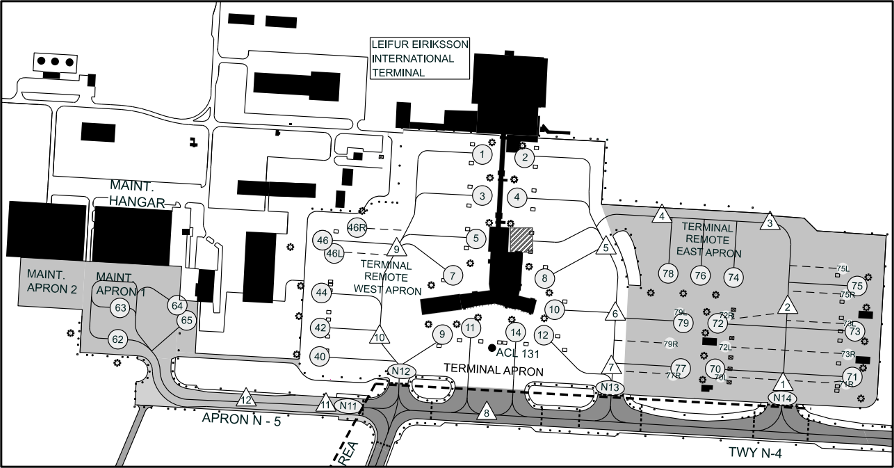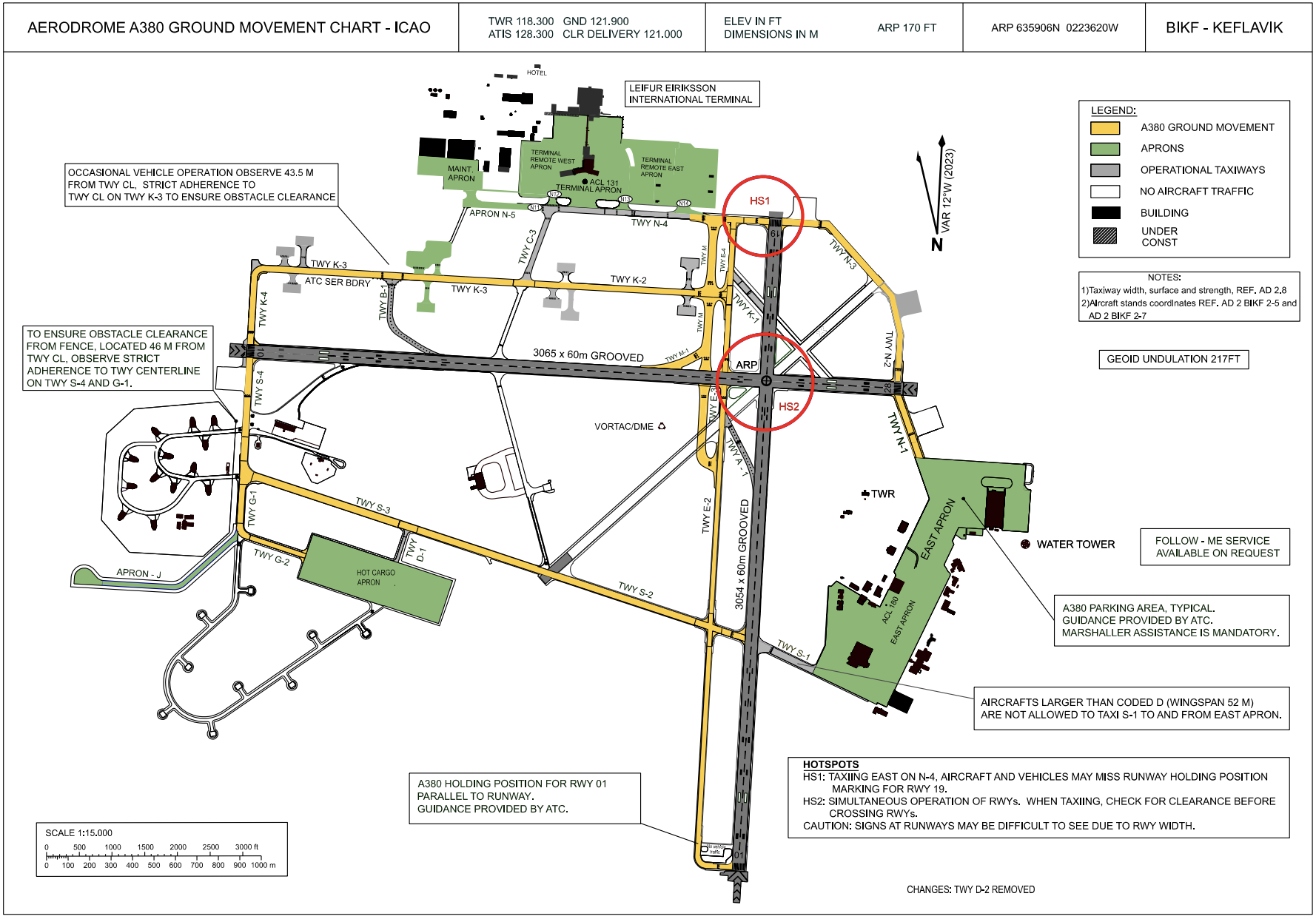Keflavik GND
Keflavik Ground (BIKF_GND, as well as BIKF_2_GND if online) is responsible for controlling the aprons and taxiways at BIKF.
Parking Locations
There are two main distinct parking areas on the aerodrome:
- Terminal Apron, also known as the "North Apron." There are two distinct sub-areas of the Terminal Apron:
- Maintenance Area – This is a separate small apron on the Western end of the complex.
- Terminal Remote East Apron - This recently opened remote parking expansion consists of the area east of N13 holding point.
- East Apron - Primarily a freight and large aircraft apron, also used for business jets (the Southern end of the East Apron hosts the FBOs) and helicopters.
Not all sceneries will have the Terminal Remote East Apron, or some of BIKF's newer taxiways such as Taxiway M and M1.
There is also the Western Complex, which is used exclusively by military fast jets operating in support of the Icelandic Air Policing mission.
The following table describes specific parking locations for specific types of flights.
|
Flight Type |
Parking Location |
|
Scheduled Passenger (Schengen Area) |
Stands 1-6 (Terminal Apron) |
|
Scheduled Passenger (Other) |
Stands 7-14 (Terminal Apron)* Terminal Remote East Apron |
|
Cargo |
Terminal Remote West Apron East Apron |
|
General Aviation |
East Apron |
|
Military |
Western Complex |
Note:
- Aircraft larger than Class D with a wingspan of 171’/52m or more are not allowed to taxi via S1 to and from the East Apron, and south of stand 111 on the East Apron.
- Aircraft parked on stands 11 & 14 must push back onto taxiway N.
- De-icing, if required, takes place on stand.
- There is a run-up area on a pad connected to taxiway N3/N2.
- There is a run-up area on a pad connected to taxiway N3/N2.
Terminal Apron
Entry Points
There are three entry points into the Terminal Apron – N12, N13, and N14. For aircraft entering the Terminal Apron, GND may specify which entry point the aircraft should leave or enter the apron from – e.g., “taxi via N12, N…” (can be helpful, but is not required.)
Departing aircraft leaving the apron should be instructed to hold short of N12/13/14 if N itself is occupied by conflicting taxiing traffic. Similarly, arriving aircraft may be instructed to give way to aircraft entering N from N12/13/14.
Tug Release Points
The Terminal (North) Apron uses tug release points for pushback. Aircraft pushing back on the North Apron will be towed to their designated tug release points.
|
Stand(s) |
Release Point |
Overflow Release Point |
|
1, 3, 5, 7, 44, 46 |
9 |
10 |
|
9, 40, 42 |
10 |
9 or 11 |
|
11, 14 |
8* *Aircraft may be instructed to face East or West depending on expected taxi route after pushback. |
|
|
8 |
6 |
4 (size category C only) |
|
62, 63, 65 |
12 or 11 |
|
|
10, 79 |
6 |
7 |
|
12, 77 |
7 |
6 |
|
76, 78 |
4 |
3 or 2 |
|
74 |
3 |
2 or 4 |
|
70, 71, 72, 73 |
1 |
2 |
|
75 |
2 |
1 |
|
55, 57, 59, 61 |
13 |
n/a |
Aircraft must not be cleared to push to a tug release point that is occupied. If the standard release point is occupied, GND should use the overflow release points in the order listed above.
GND should state the tug release point in the push & start clearance. For example:
🎧 ICE502, push & start approved, release point 5, QNH 1024.
NOTE: Some pilots, particularly in older simulators, may not have the ability to push to a specific release point. If this is the case, then GND may clear the aircraft for pushback without specifying a tug release point. GND should be cautious of other traffic that is taxiing or pushing back.
A380 Ground Movement
Due to the massive size & wingspan of A380s, specific taxiways have been designated for A380 ground movement.
A380s may only be taxied on the yellow taxiways marked above, and should only be parked at the A380 parking area on the East Apron (stand 120.) A380s are also expected to use the A380 holding position for RWY 01, parallel to the typical E1 holding point for RWY 01 (see bottom of the chart).
Controllers may also consider strategically taxiing or backtracking aircraft via the runways to shorten A380s’ taxi distance.
Secondary GND Position
BIKF has an overflow aerodrome frequency, which for VATSIM purposes has the login callsign BIKF_2_GND.
BIKF_2_GND may relieve any of the responsibilities of either BIKF_GND or BIKF_TWR. E.g., it may take over apron control while BIKF_GND controls the taxiways. BIKF_2_GND may only be opened with the approval of the existing BIKF_GND (if performing Ground responsibilities) or BIKF_TWR (if performing Tower responsibilities) controllers.
BIKF_2_GND may adopt the callsign “Keflavik Ground” or “Keflavik Tower,” depending on whether it is performing Ground or Tower responsibilities.


